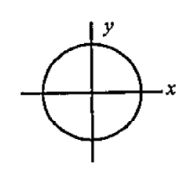In a certain region of space, the potential field depends on x and y-coordinates as . The corresponding electric field lines in xy-plane are correctly represented by




To solve the problem, we need to find the electric field corresponding to the given potential field V=−x2+y2. The electric field E is related to the electric potential V by the equation:
E=−∇V
where ∇V is the gradient of the potential V. In two dimensions, the gradient can be expressed as:
∇V=(∂V∂x,∂V∂y)
Step 1: Calculate the partial derivative of V with respect to x
The potential function is given by:
V=−x2+y2
Now, we differentiate V with respect to x:
∂V∂x=∂∂x(−x2+y2)=−2x
Step 2: Calculate the partial derivative of V with respect to y
Next, we differentiate V with respect to y:
∂V∂y=∂∂y(−x2+y2)=2y
Step 3: Write the components of the electric field
Using the relation E=−∇V, we can find the components of the electric field:
Ex=−∂V∂x=−(−2x)=2x
Ey=−∂V∂y=−2y
Thus, the electric field vector can be expressed as:
E=(2x,−2y)
Step 4: Analyze the electric field lines
To analyze the electric field lines, we can express the relationship between Ex and Ey:
EyEx=−2y2x=−yx
This implies that the electric field lines can be represented by the equation:
y = -kx \quad \text{(where k is a constant)}
This indicates that the electric field lines are straight lines passing through the origin with a negative slope.
Step 5: Identify the correct representation among the options
From the options provided, we need to identify which graph represents straight lines with a negative slope. The correct representation will be the one that shows straight lines in the xy-plane.
Final Answer
The correct representation of the electric field lines in the xy-plane is option B.
---
y = -kx \quad \text{(where k is a constant)}
Similar Questions
Determine the electric field strength vector in a region if in space the potential of this field depends on x and y coordinates as V=a(x2−y2).
View SolutionDetermine the electric field strength vector if the potential of this field depends upon x - and y - coordinates as :
(i) V=a(x2−y2)
(ii) V=axy.
View Solution
Knowledge Check
In a certain region of space, the potential is given by V=k(2x2−y2+z2). The electric field at the point (1, 1, 1) has magnitude:
Ak√6B2k√6C2k√3D4k√3In a certain region of space , the potential is given by : V=K[2x2−y2−y2z2]. The electric field at the point (1.1.1) has magnitude =.
Ak√6B2k√6C2k√3D4k√3In a certain region of space the electric potential V is known to be constant. Is the electric field in this region (a) positive (b) zero ,or (c ) negative ?
AAlso constantBPositiveCNegativeDZero
In a certain region of space the electric potential V is known to be constant. Is the electric field in this region (a) positive (b) zero ,or (c ) negative ?
View SolutionIn certain region of space with volume 0.2 m3 the electric potential is found to be 5V throughout. The magnitude of electric field is this region is
View SolutionIn a certain region of space, the electric field is zero. From this, we can conclude that the electric potential in this region is:
View SolutionIn certain region of space with volume 0.2 m3 the electric potential is found to be 5V throughout. The magnitude of electric field is this region is
View SolutionDetermine the electric field strength vector if the potential of this field depends on X, coordinates as V = 10 axy
View Solution